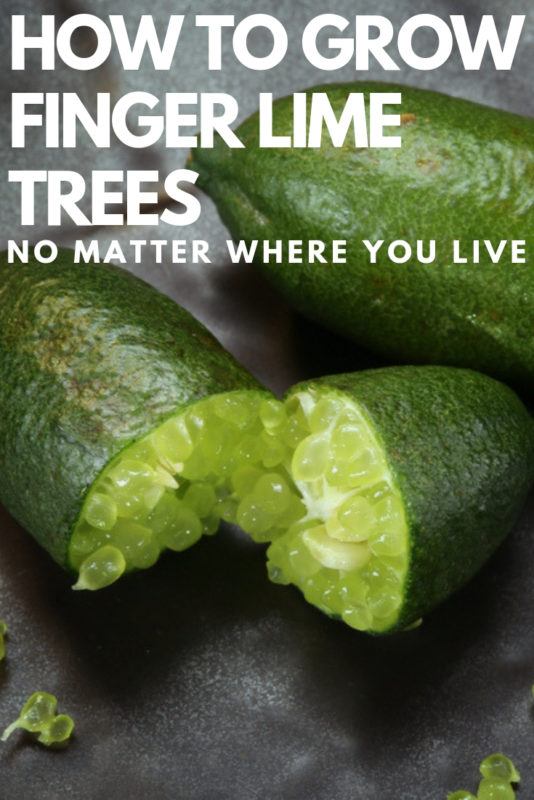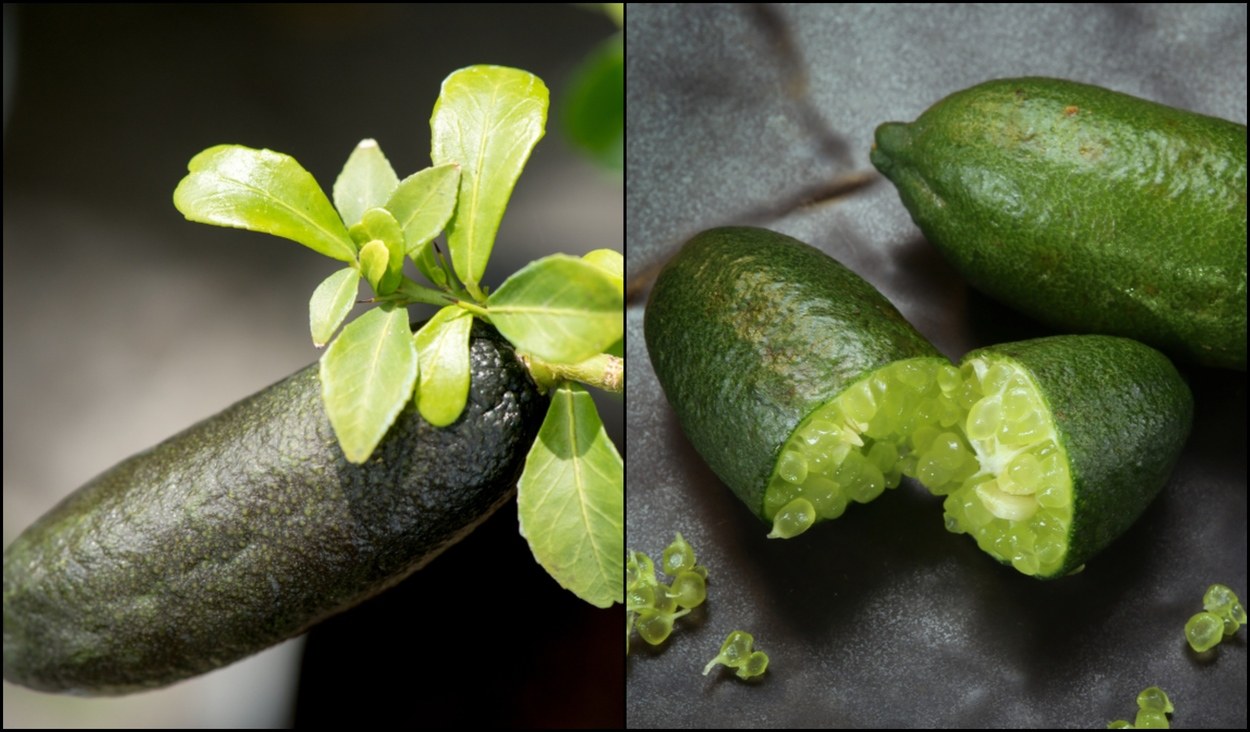
The Finger Lime tree (sometimes referred to as Caviar Lime) is native to Australia and true to its common name, the small elongated fruit is the size and shape of a fat finger.
If it’s not yet as popular as it should be, that’s not for any lack of demand. The production of this gourmet item just cannot keep up with the demand in culinary circles. This is one good reason to grow your own.
This small citrus species is cherished for its tiny, juice-filled pearl-like vesicles, which give it the epithet ‘lime caviar.’
They may be green, white, pink or red, depending on the variety. Served as a topping on seafood, salads or soups, they give a surprising twist to the dish as they burst on the tongue releasing their tangy citrusiness.
The Finger Lime Tree In Its Natural Habitat
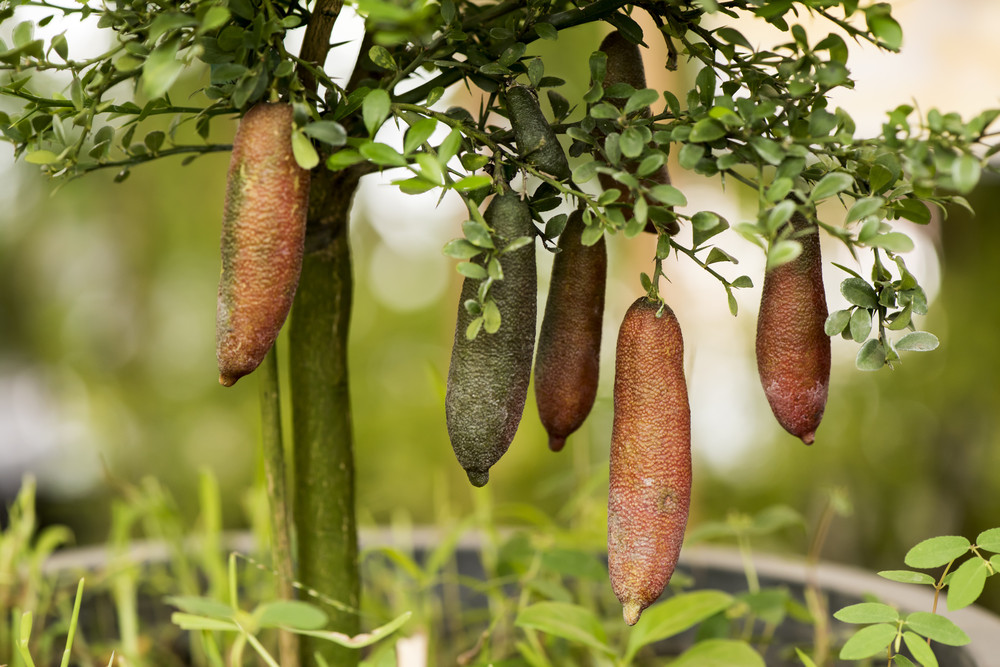
Native to the lowlands of New South Wales and Queensland, the Australian Finger Lime (Citrus australasica) tree typically grows wild in warm and humid subtropical rainforest.
It is more of a large shrub than a tree and forms the understory in coastal forests. Therefore, it prefers slightly acidic soil and partially shady to sunny locations.
The Finger Lime tree doesn’t exactly look like your typical lemon or lime tree, although it has plenty of sharp thorns. The leaves are rather small and the branching is irregular. The small fruits measuring 1-4 inches, resemble legume pods as they hang from the branches. They may be various shades of green, red, brown or black.
Finger Lime trees can tolerate cold weather to some extent, but not frost. Established plants can withstand drought, but even moisture in the soil is preferred. It is particularly important for young plants.
Growing The Australian Finger Lime Tree
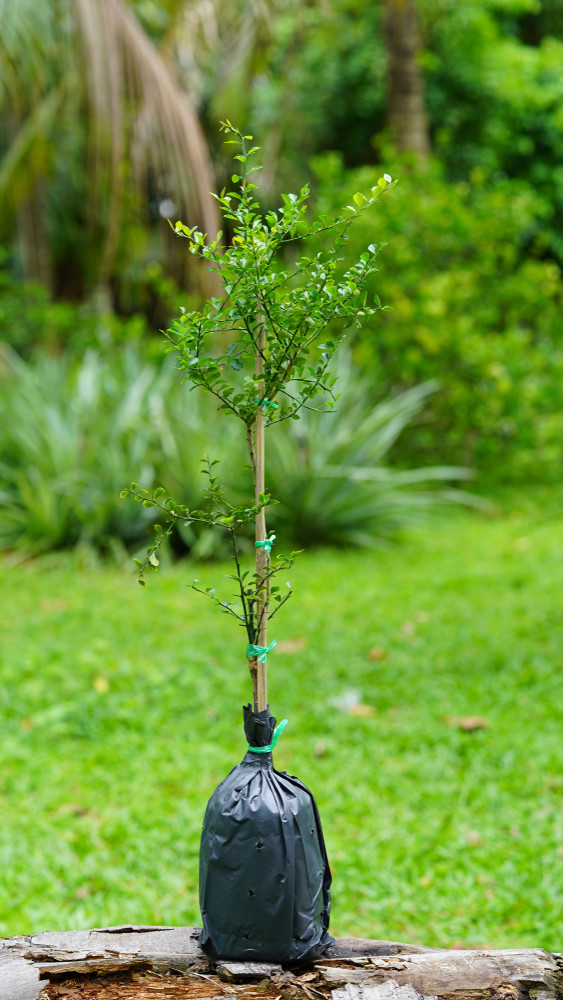
Australian Finger limes were originally a bush food that early settlers foraged from the wild. As it started getting attention from the culinary world, commercial cultivation began in the 1990s. The fruits were still not seen outside the continent until the early 2000s.
Grafted rootstock is commonly used as planting material. Finger Lime trees can be grown from seeds and semi-hard cuttings, but they have some drawbacks.
Seedlings grow very slowly and usually take up to 15 years to start fruiting. They are also more particular about growing conditions. As for those grown from cuttings, they often fail to thrive and are more vulnerable to diseases.
Grafted rootstocks will give you mature plants much more quickly. They could start fruiting in just 2-3 years, although it may take another 3-4 years for them to have a good yield.
Another advantage of grafting is that rootstocks that can withstand adverse climatic conditions could be used, which makes the trees more tolerant of the vagaries of nature.
Considering their natural growing conditions, coastal Florida and California may be ideal for growing Finger Lime trees out in the garden.
However, they can be successfully grown in pots irrespective of where you live, as long as you provide natural growing conditions. As a matter of fact, growing Finger Lime trees in pots has several advantages.
6 Reasons To Grow Finger Limes In Pots
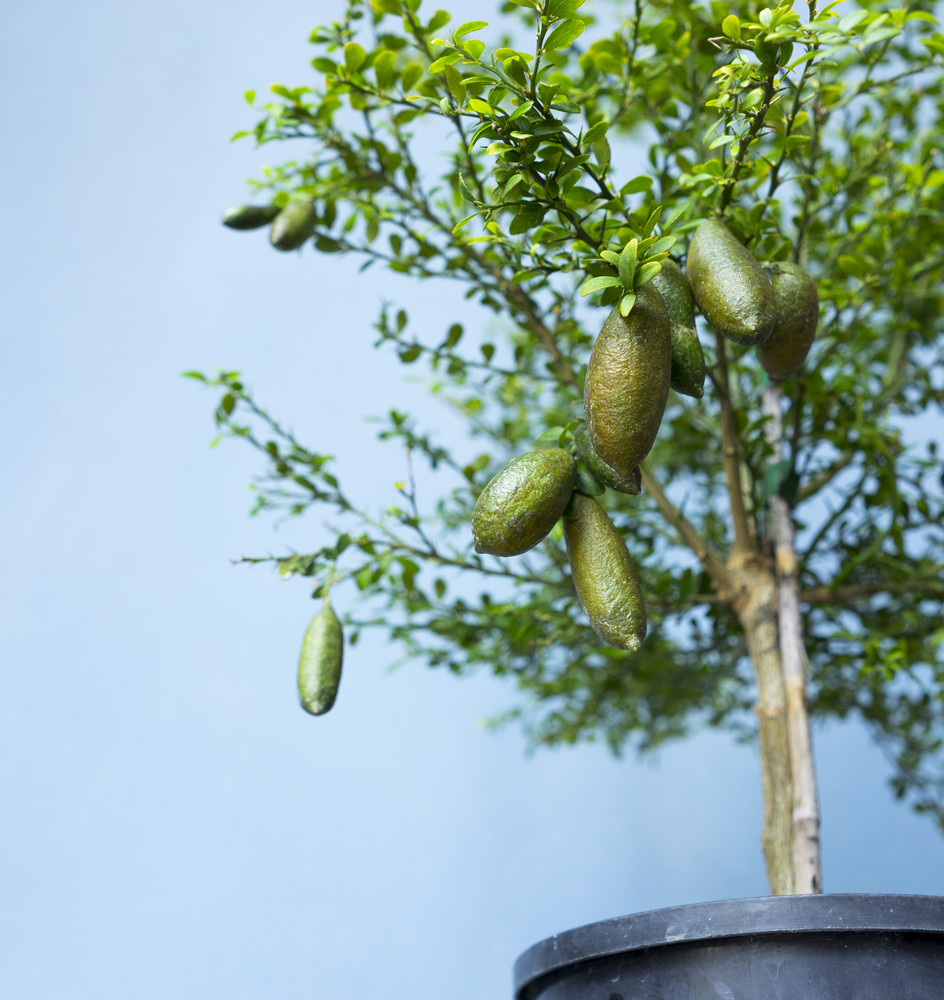
1. Maintaining Correct Soil pH
The Australian Finger Lime tree does well in a pH range of 5 to 6.5. It’s easier to maintain this condition in containers than in the ground.
2. Providing Good Drainage
The Finger Lime tree naturally grows in areas with high humidity and frequent rains, especially in summer. Although it can tolerate short periods of drought, it prefers evenly moist soil, but with good drainage to avoid waterlogging.
3. Protection From The Elements
These shrubby trees need to be sheltered from the wind and cold not only when they’re young. Mature trees and their fruit are also susceptible to wind and cold damage.
Too much hot sun can also burn the fruit. When the fruits are maturing, a rogue shower can cause them to split and rot to set in. Those growing in containers can be moved to a protected location whenever required.
4. Harvesting Mature Fruit
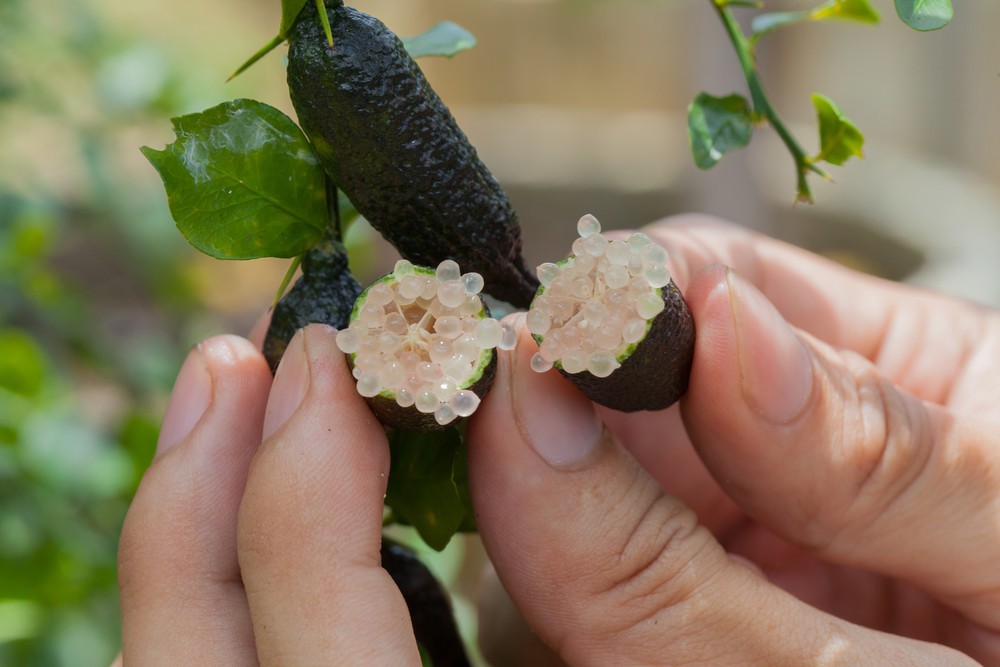
Finger limes are best when they mature on the tree. You not only get the best flavor, but the fruits keep for a long time without damage. Harvesting on time is easy when this tree is grown in a container.
5. Controlling Size
Finger Lime trees are naturally small in size, which makes them ideal for growing in containers. However, their thorny branches may need occasional pruning. This, as well as picking fruits, is a lot easier with pot-grown plants.
6. Checking For Pests & Diseases
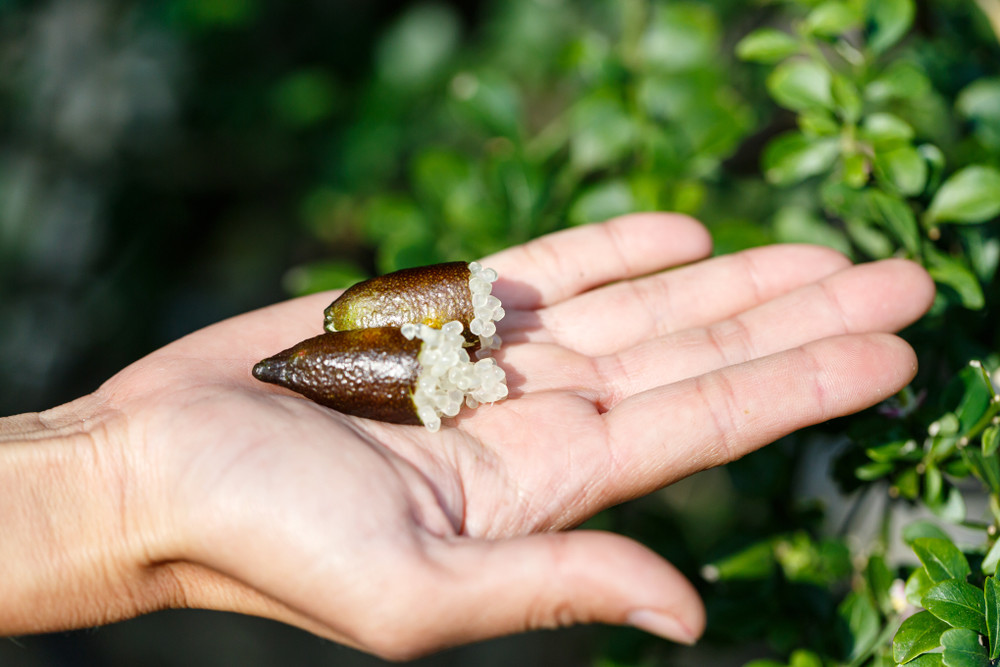
Finger Lime trees are not very disease-prone, but fungal rusts, scale, and aphid infestations are common. In areas with lots of citrus trees, attack of citrus gall wasp may be a problem.
It is easier to check for and identify problems when you have the tree in a container. It is also protected from common soil pathogens, especially nematodes.
Growing The Australian Finger Lime Tree In Containers
Choose The Right Container
Choose the largest size pot that’s practical for you. You don’t want to shock your Finger Lime tree by frequent repotting.
Start with a 5-gallon pot at the least, to give enough space for the roots to spread out. A larger container, 15-gallon or bigger, is even better, but it can also be difficult if you need to move it frequently. Keeping the container on a heavy duty plant caddy might help – you can buy them here on Amazon.
A terracotta or plastic container will do. Terracotta is better if you tend to overwater and plastic pot if you’re likely to forget the schedule.
Whatever the material, the most important consideration is drainage. The Finger Lime tree likes regular watering, preferably every 3-4 days, so the container should have holes to let the excess water drain away. Grow bags are also a good option because they allow water to evaporate faster.
Read Next: 40 Unique & Fun Container Garden Ideas
Use Good Quality Potting Soil
Fill the pot two thirds with good quality potting soil with some extra sand and bone meal mixed in. Sand will ensure drainage and bone meal will serve as a slow release source of calcium and phosphorous that citrus plants need.
Finger lime trees themselves are not too particular about soil fertility; they’re not bothered by poor soil in their natural habitat. However, the rootstocks they’re grafted on like rich soil to thrive.
Find A Good Location
This understory tree grows in dappled light in its subtropical home, but it does well in a sunny location, especially in cooler areas. Some shade in the afternoon may be appreciated in summer though. You can grow this tree indoors as long as it receives six hours of sunlight.
Selecting The Varieties To Grow
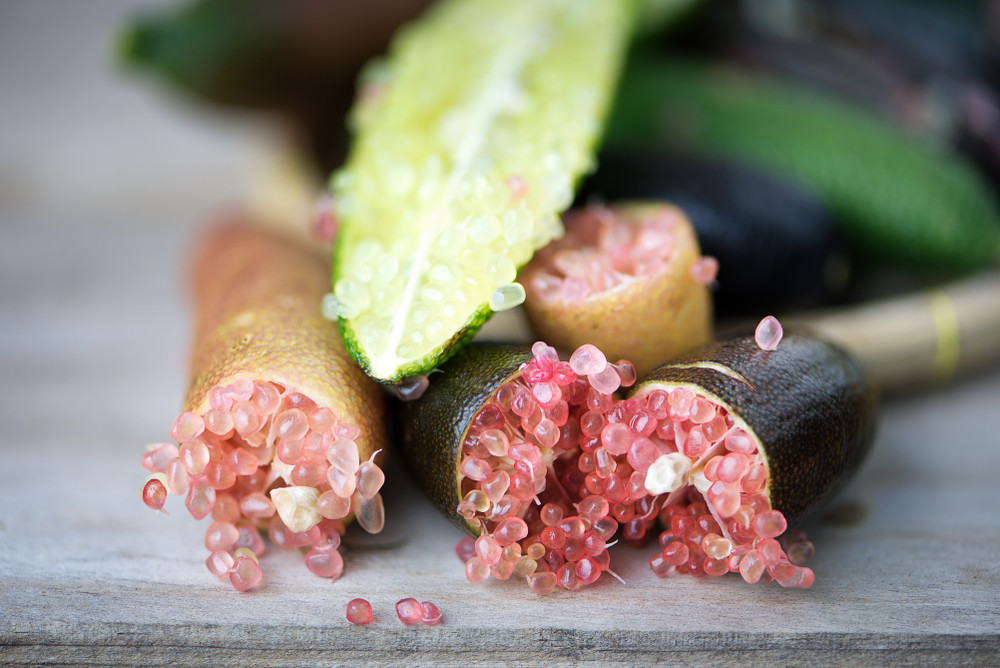
Selection of Australian Finger Lime trees may be limited by the availability of grafted trees locally. Several new hybrids have been developed in recent years, but not all plant nurseries have them in stock, and there may be restrictions on shipping.
Color of the lime caviar is usually the main criteria for selection, although it may be just as delightful in any color.
The hybrid ‘Blood Lime’ has bright red flesh, while ‘Rainforest Pearl’ is a pink-fleshed variety. ‘Durham’s Emerald’ bears black fruit that has bright green flesh. ‘Judy’s Everbearing‘ has clear flesh and bears a few fruit round the year. ‘Alstonville’ is a heavy producer with pale green flesh.
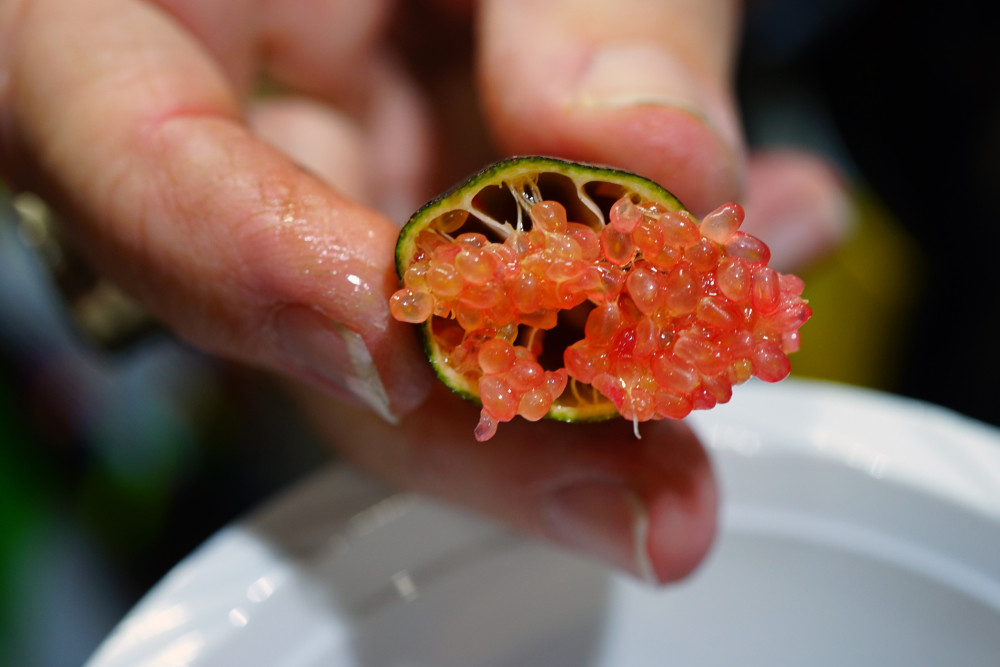
Some of the named varieties are protected by breeder rights registrations, so take care to buy your plants from reputed nurseries.
Watering
The Finger Lime tree likes soil that’s evenly moist, but not too wet for extended periods. It comes from an area that receives summer rain, so you should not allow the soil to dry out completely. Water it twice a week or when the top layer of soil is dry to touch. A layer of mulch might help keep the soil cool and moist.
Avoid overwatering or waterlogging, as it may kill the plant. A pebble tray may be kept under the pot to increase humidity, but the pot itself should not be sitting in the water.
Feeding
Australian Finger Lime tree is not a heavy feeder, but it requires a small dose of nutrients once every 3 months.
Top dressing with compost, seaweed extract or fish emulsion will help keep the soil rich and healthy as the growing tree uses up the soil nutrients. Diluted compost tea or worm tea may be used as a foliar spray for an extra boost.
Flowering & Fruit Set
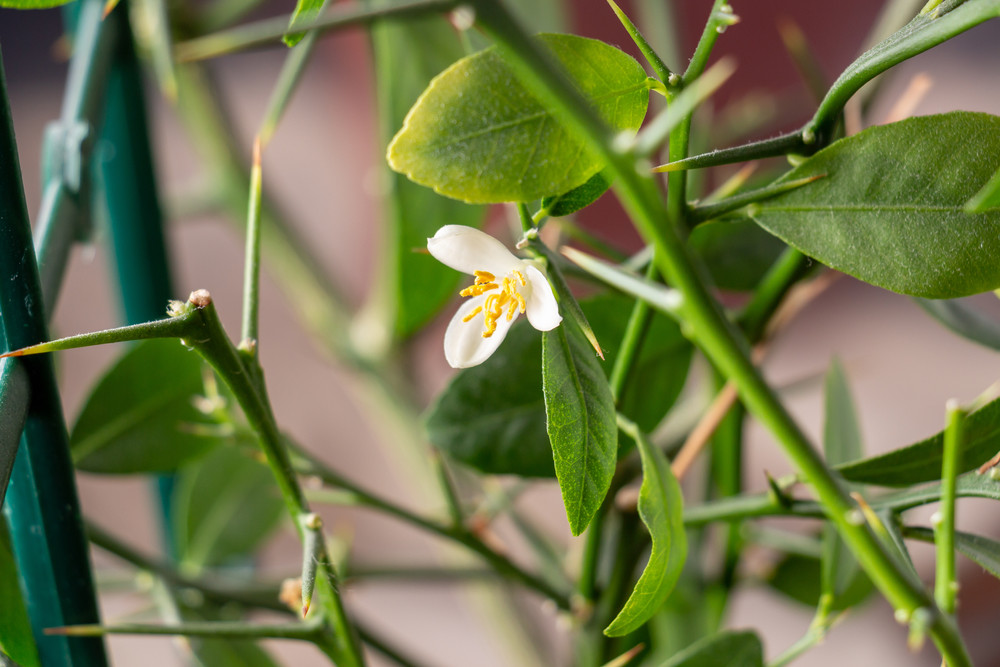
After your Finger Lime tree is well established, you may have to wait a while to get the fruits. Grafted trees start flowering in their second or third year because their rootstock comes from mature lime trees.
Flowers typically appear in winter (which is June to August in Australia in the Southern hemisphere) and the flowering continues into spring. The fruits take 5 months to mature and become ready to pick by the end of summer.
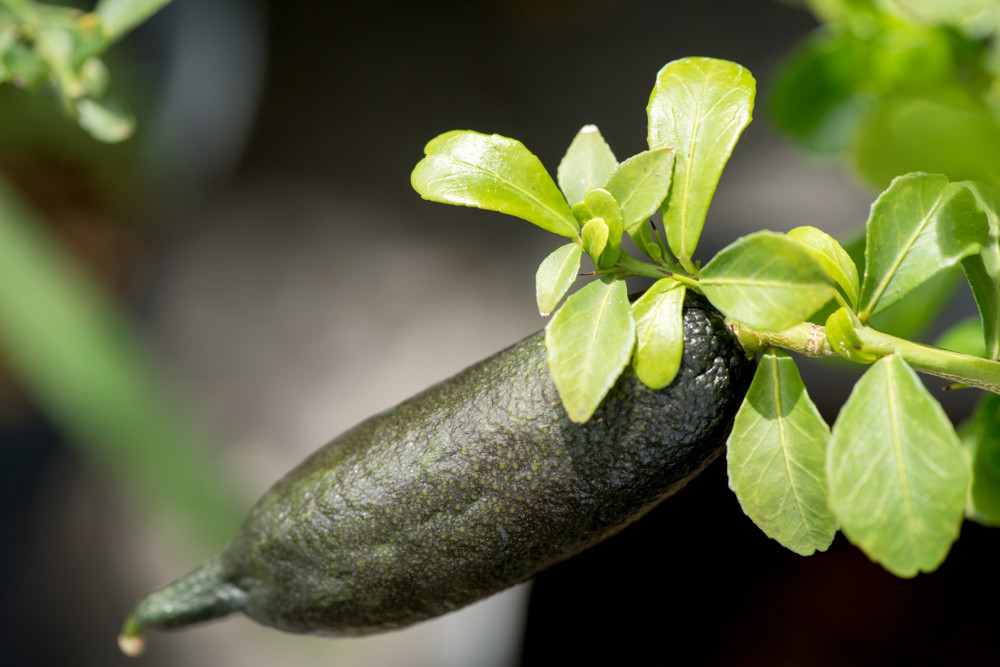
Once the tree starts flowering, feeding should be stopped until the fruits are 1 inch long. The fruits fill out and change color as they mature, indicating they’re ready to be harvested.
Have your gardening gloves ready to handpick them from among the thorny branches and enjoy.
Where To Buy A Finger Lime Tree
You may find a Finger Lime tree in your local plant nursery or garden center, or they may be able to order you one in.
You can also order Finger Limes online. Nature Hills Nursery is one such nursery that offers plants and trees for sale, including this beautiful Finger Lime tree.
Pin This To Save For Later
